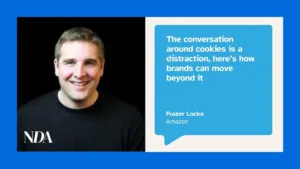Rob Webster is Founder of Canton Marketing Solutions. He’s worked in the adtech industry since 2001 and is NDA’s monthly adtech columnist.
It’s obviously been a tough recent period for Facebook. From the outage which amazed me in its ability to generate column inches for what is really a fairly minor thing (a social network being unavailable for less than a day) to constant articles into how Facebook harms individuals and our society at large amid calls for regulation.
As advertisers it is us that effectively funds Facebook and whilst I dont think its appropriate in this column to analyse deeply the individual challenges raised by Facebook I do think it appropriate (and think the advertising industry need to) look at what principles and mechanisms we would like in place to have a better future for social media such that issues as they arise can be better dealt with by both the advertising community as well as Facebook.
That myself as someone who has worked for 20 years in digital ad technology and the very digital savvy readers of NDA we might be able to better come up with and articulate solutions better than others. To anyone who proceeds I would love their feedback and engagement to this such that together we might actually make a difference and improve something which could have far reaching benefits to the industry and far beyond. To avoid doubt from now on when we are referring to Facebook we are including the phenomenon that is Instagram within the Facebook audience network but not yet really considering whatsapp (that Facebook also owns) as it is not yet an advertising platform.
A marketing phenomenon
Before we go any further I think we first need to address why Facebook is so important and why previous calls for a facebook boycott on certain issues have been unsuccessful. Facebook is by a distance the greatest audience targeting platform the world has ever seen. I don’t believe you can truly call yourself an expert in data driven or programmatic marketing if you are not an expert in Facebook. With around 2.9 billion active monthly users on the platform globally, 200 million in the US and 38 million in the UK the reach is staggering. In the US and UK most users spend nearly an hour a day on Facebook.
Much of that time is spent on mobile phone apps and ad platform Facebook dominates – Facebook is without a doubt the most important app publisher. Alongside this huge volume and reach is amazing data, with all users logged in and giving reliable data on age, location and interests the data opportunity is enormous and we haven’t even got to the best bit yet. Facebook has email address data that mostly matches the email addresses people actually use – combined with terms and conditions that users sign up to that cover the use of that data (somewhat, this is not a privacy review piece) and so advertisers can and do upload their own customer audiences to facebook for customer targeting and for the building out of huguely powerful lookalike audiences.
Add all this together with ad formats that suit the mobile app environment like a glove, Facebook and Instagram are both chock full of adverts that are intrusive enough to provide advertiser value and yet most users seem not to mind. For all these reasons and more, Facebook is an advertising phenomenon that cannot be ignored.
Emerging rules.
Facebook advertising has changed much in its roughly 10 year lifetime. From FBX (Facebook’s DSP retargeting product) closing with much teeth gnashing back in 2013 to the big restriction in data usage after the Cambridge Analytica scandal. The biggest and most recent significant policy change has been little discussed. For the last 2 years in North America and coming to Europe in December Facebook will no longer allow advertisers in Politics, Credit, Employment or Property use its Age and Gender data or indeed GEO beneath a 9 mile radius.
This is to guard against micro targeting being misused in these sectors or opening up possibilities of discrimiationion. For example, by showing employment ads in only richer areas of a city you would be engaging in discrimination. I might argue that in property this is overly restrictive however and that in general its pushing advertisers to more opaque targeting. None of this takes away from the fact that in pushing these rules Facebook is taking many millions of ad dollars off the table in the pursuit of fairer advertising.
Advertising Principles that are worth pushing.
So as an industry what principles of regulation (either self or imposed) should we be recommending. I would like to push the following principles to help move the situation forward. Precision here is vital, in the past Advertisers demands have come to nothing as what they have asked for is not practical and Facebook has been able to obfuscate away from responsibility. This is where we as experts and practitioners can provide that precision and detail and be qualified to judge any pushbacks. Industry bodies have tried hard here but many have been held back by their conflicted memberships and/or lack of specialist expertise. What is needed is a consensus that cuts through traditional lines.
Principle 1) Targeting independently-verified safe content.
The right to run targeting that removes content the advertiser does not believe is acceptable. In the world of TV if certain TV programs are not deemed acceptable the advertiser simply blocks their ads appearing next to them – not boycotting all of TV. Facebook’s scale means that blocking all of Facebook over specific issues is not practical – less than 1pc of revenue comes from the top 10 advertisers and their long tail advertising and scale make it impractical to run a boycott.
What is needed is for Facebook to allow advertisers to ensure they don’t appear against content that advertisers hate (recent examples could be racist content or anything pushing misogyny or hate). This involves two concepts, Brand Safety and Brand Suitability which need to be brought into the Facebook targeting world. Brand Safety is the floor- anything that is not brand safe should not be monetised by any brand (illegal content, misinformation, etc.). Brand suitability is the next level-up, it is more focussed on the level of risk or suitability that a client is willing to go to. Identifying controversial content and removing advertising from has the double benefit of protecting advertisers but also more importantly helping identify and protect individuals.
GARM – The global alliance for responsible media has been pushing for big improvements here and Facebook is a founder member. Yet progress can be slow and a lot of that is down to some of the inherent difficulties. In a user generated content world where Facebook has separate feed content systems to ad decisioning this is not straight forward. Yet these problems can be solved – keywords and text can be anonymised and passed to the decision engine – Images and Videos can be verified by AI or humans (with time).
These are areas the independent ad tech world has developed great technology for (the open sectors are more human than technology) and Facebook has billions of dollars to spend on improving the status quo. A greater role for the independent sector would also give this a huge boost. Technology exists that can scan images in real time and blocking against keywords is a technology that has been around for a long time so there really is no excuse for the lack of meaningful progress.
Reaction times are important too. Poor content will always slip through the net. Yet right now even when breaches have been found advertisers have little they can do to rectify situations. The join between content and advertisement must be made and combined with the tools to block known keywords, images and content types must be established.
Principle 2) Measurement Numbers Need to be verifiable and ideally independently audited.
My biggest challenge with Facebook advertising is needing to take the measurement numbers on complete trust. They make enormous benefit from Post View attribution numbers in the FAN which are completely unverifiable and un dedupable (looking for duplicate sales) across other channels – this is a shocking situation for advertisers. Once upon a time we could look at the sales figures and analyse the sales orderIDs Facebook was claiming. Even this is no longer allowed on privacy reasons, which I think is disingenuous – most other platforms allow the reporting of OrderIDs without any way of identifying the user.
This moves further into the attribution, post click numbers can be somewhat compared and validated against web analytics yet post impression numbers – which Facebook recommends to reward media spend – are completely unverifiable. Now PV measurement is hard in a privacy first world and Facebook does have excellent expose v control testing capabilities. Yet taken as a whole this makes advertiser measurement into Facebook more opaque than in other large platforms or across the open web. For good reasons of privacy data on userIDs is not going to be forthcoming yet I do think that OrderIDs alongside the time and format of different engagements (by type) should be downloadable by all advertisers such that it can be built into their measurement models.
More oversight by independent arbiters and possibly industry bodies would also allow for a great role for independent technology and needs to be expanded beyond just the current two or three vendors (to a sensible number, not hundreds, probably less than 10).There really is no valid reason for not doing this – indeed independent auditing of numbers could also be easily done provided that user IDs were not exposed – this would mean obfuscating any ID and or potential ID ( like IP address and user agent) into a sensible cohort structure. The Facebook clean room is becoming a possible solution here but needs more development and adoption as well as the ability to download anonymised data so it can be built into a holistic all media reporting setup – this includes allowing the exposure of orderIDs in reporting as a must.
Technology can play a key part in this. Data Clean Rooms and other privacy preserving technologies can play a big part. Interoperability though is key and this needs to be brought out from behind Facebooks walls (without exposing user data). This is where industry must demand precise standards, methods and data points. The issue is not technical but precision of guidance.
Principle 3) Transparency and Independent oversight into crucial technologies. Including Targeting criteria and Incrementality experimentation.
A hugely important part of advertising is trust. Given that using Facebook Audience network for most advertisers is a must given the scale, it’s almost a public utility now as the telephone network became nearly a century ago. So advertisers and the public at large need to have confidence in how crucial features operate and that they do so fairly and equitably. Two areas that I would call out are how ads are targeted and how incrementality testing is carried out.
For the targeting criteria, much of Facebook targeting is becoming more “Black Box”. From the special ad categories described above for Politics, Education, Credit and Property through to the more mainstream use of “lookalikes” and Facebook optimised performance. Some of what happens here is understandable Facecbooks IP and “Secret Sauce” and yet a general understanding in how it works and oversight that it not be something that causes society in general (as well as advertisers) harm is vital. If we are to trust the veracity of ever more complex and opaque techniques we need such techniques to come under some scrutiny.
For doing this is in Facebook’s interest too as it will increase trust in the product from consumers and advertisers alike. How to “Audit” an algorithm is something in much debate in parts of the ad and marketing technology world (and us consultants that are adjacent) yet what is possible to audit is the real world outputs and testing of hypothesis against the algorithms real world results. We are talking about a trillion dollar ecosystem here and such oversight is both possible and desirable provided it is handled correctly.
Incrementality testing is the second area and something very close to my heart in building a better future for advertising. Facebook has built an amazing expose/control and holdout testing tool that I would encourage all advertisers to use (and action the results) extensively. Yet the power of this tool is only as good as the confidence in it and its something that could be manipulated both deliberately and accidentally. For any public company the temptation to tweak how these systems operate to boost their revenues when knowing the likelihood of them being caught (with any real evidence) are so slim. There are probably other systems that deserve similar attention and yet focus here and on the aforementioned targeting technologies are where I would start.
I really hope this article has helped some in thinking about how we can better work with the Facebook Advertising phenomenon (and indeed these principles apply way beyond). Its really important as I said at the start that as an industry we come together to drive a better future here as only we have the expertise to do this right. As an example of how things go when regulation is forced upon us look at GDPR, which whilst it is doing much that is good, unintended consequences include putting more power in the hands of the giants. I hope to hear from as many of you as possible some feedback on my principles and suggestions and hope that we can together build a better future.









